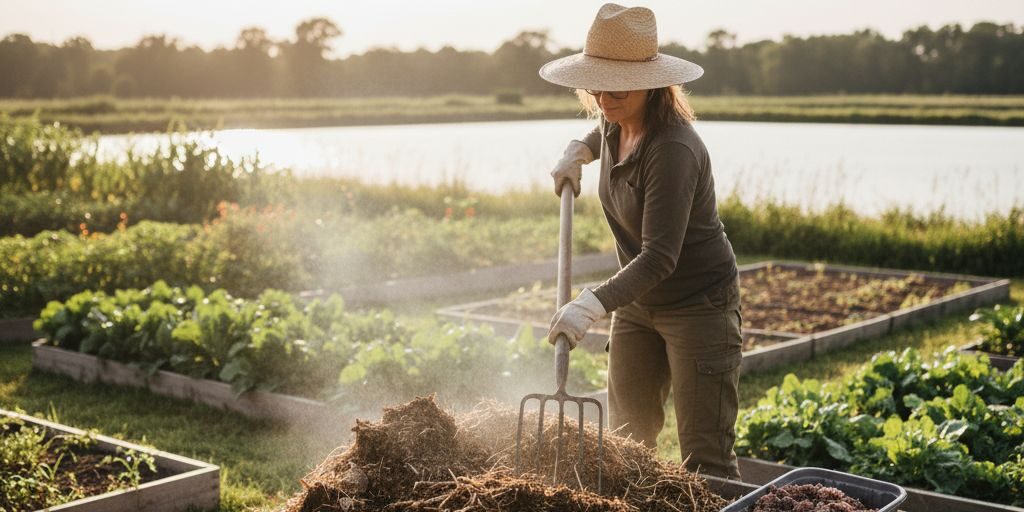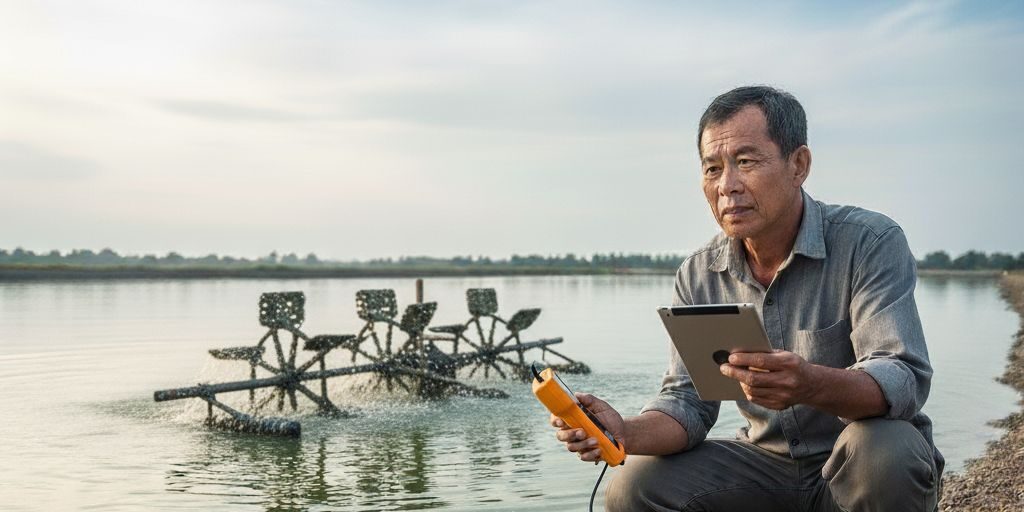- Software Gestor para Aquicultura
- (85) 2139-6730
- contato@despesca.com.br
Aquaculture Waste Disposal: A Comprehensive Guide to Techniques and Utilization

Water Grant: Ensure the Legal Right to Use Water for Your Aquaculture Production in Brazil
25/09/2025
Efficient Cash Flow: 10 Essential Tips for Your Farm
29/09/2025Aquaculture waste disposal presents one of the biggest operational and environmental challenges for fish and shrimp producers. Inadequate management not only entails risks of contamination and diseases but can also result in legal sanctions and productivity losses. However, with the right approach, what is often seen as a problem can be transformed into an opportunity, adding value and sustainability to the business.
Aquaculture production, by its nature, generates organic and inorganic waste, primarily from uneaten feed and animal excretions. Consequently, the concentration of compounds such as nitrogen and phosphorus in the water increases, which necessitates careful management to prevent the deterioration of the cultivation environment and the surrounding ecosystem. This article discusses the main techniques for the effective treatment and smart utilization of these residues.
Why is Waste Management Crucial?
The importance of a waste management plan extends beyond merely complying with environmental regulations. First, the stability of the cultivation system itself depends on it. The accumulation of organic matter at the bottom of ponds, for example, creates anaerobic zones that release toxic gases, such as hydrogen sulfide (H2S), which is highly detrimental to fish and shrimp.
Furthermore, discharging nutrient-rich effluents into natural water bodies can cause eutrophication, a phenomenon of excessive algal bloom that drastically reduces available oxygen and affects all local aquatic life. On the other hand, efficient management strengthens the farm’s biosecurity, decreasing the pathogen load and improving overall stock health. This directly translates into reduced medication costs and improved feed conversion rates.
Main Types of Waste in Aquaculture
The generated waste can be categorized into two main groups, each requiring a specific management approach:
- Liquid Effluents: This refers to water discharged from ponds or tanks, laden with dissolved nutrients (ammonia, nitrite, nitrate, and phosphate) and suspended organic matter.
- Solid Waste (Sludge): This is the material accumulated at the bottom of ponds, composed of feces, uneaten feed, and dead microorganisms. This sludge is extremely rich in organic matter and nutrients.
Techniques for Waste Treatment and Utilization
Fortunately, various technologies and practices are already well-established for managing these wastes effectively, transforming them from environmental liabilities into economic assets.
Liquid Effluent Treatment
Treating water before its discharge or reuse is fundamental. One of the most efficient strategies is the use of settling basins, where pond water flows through a tank at a low velocity, allowing suspended solid particles to decant. The clarified water can then be directed for further treatment or reused.
Another advanced approach is Integrated Multi-Trophic Aquaculture (IMTA). In this system, the waste from one species becomes food for another. For instance, effluents from fish farming, rich in nutrients, can be used to irrigate microalgae or macroalgae cultivation, which in turn filter the water and can also be commercialized. Similarly, shellfish like oysters and mussels can be integrated to filter particulate organic matter.
Solid Waste (Sludge) Utilization
Sludge removed from the bottom of ponds is a valuable resource. After drying, this material can be treated and utilized in various ways:
- Composting and Biofertilizers: Aquaculture sludge is an excellent component for producing organic fertilizers. Through composting, it is stabilized and transformed into a nutrient-rich product that can be used in agriculture, restoring soils and generating a new revenue stream for the farm.
- Anaerobic Digestion: In larger-scale projects, sludge can be directed to biodigesters. In this process, bacteria decompose organic matter in the absence of oxygen, producing biogas (mainly methane), which can be used to generate electricity or thermal energy for the farm itself, reducing operational costs. The liquid byproduct, known as biofertilizer, also has high agronomic value.
The Role of Technology in Waste Management
Accurate monitoring is the foundation for any waste management strategy. Therefore, the use of a management software, such as Despesca, is a competitive advantage. Through the platform, producers can systematically record and analyze water quality parameters (referencing the Portuguese link as an example, ideally this would link to an English version if available), correlating them with feed provided and animal growth.
This data allows for identifying patterns and predicting waste generation, making management planning much more efficient. Moreover, rigorous control over the costs of each operation, from feed purchase to effluent treatment, is simplified. With organized records, the farm is also better prepared to obtain sustainability certifications and quality seals, which open doors to more demanding and profitable markets.
Conclusion: Turning a Challenge into an Opportunity
In summary, proper aquaculture waste disposal has evolved from merely an environmental obligation to a strategic component of production. Adopting techniques such as settling basins, IMTA, composting, and anaerobic digestion, combined with the use of management tools like Despesca, allows producers not only to mitigate environmental impacts but also to create new revenue streams and optimize their costs. Sustainable production is, above all, smarter, more resilient, and more profitable production.




